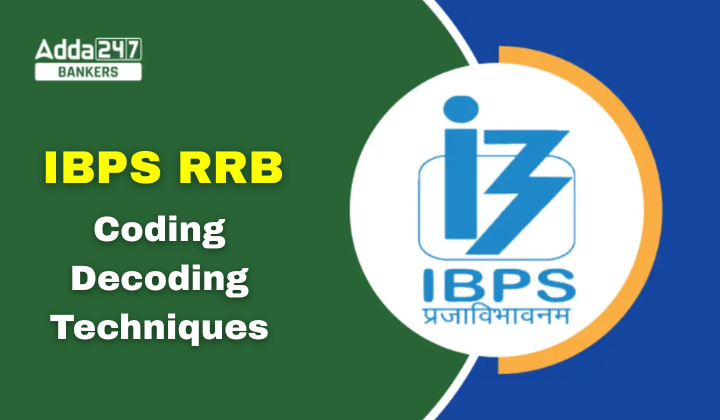Coding-Decoding is an important part of the Reasoning Ability section in the IBPS RRB PO and Clerk 2025 exam. This topic assesses the candidate’s logical thinking and analytical skills by presenting coded messages that follow specific patterns or rules. It includes a variety of questions where words, letters or numbers are encrypted in a particular format and the candidate must decode the logic to arrive at the correct answer.
Coding-Decoding for IBPS RRB PO and Clerk 2025
With the emerging trend of banking exams, coding-decoding questions have become more varied and challenging. Techniques such as alphabet shifting, reverse order coding, alphanumeric-symbolic coding and matrix-based decoding are frequently used. Mastering these techniques not only helps in solving such questions faster but also improves overall accuracy and boosts performance in a competitive exam environment.
Types and Techniques of Coding-Decoding for IBPS RRB PO/Clerk
Coding-Decoding is a crucial topic in the Reasoning Ability section of the IBPS RRB PO and Clerk exams. It assesses the candidate’s ability to identify patterns, apply logical rules, and decode a given code efficiently. The questions in this section can be based on various techniques and types of coding. Below are the key types and techniques of Coding-Decoding that candidates must master for the IBPS RRB PO and Clerk exams.
1. Binary Coding-Decoding
In binary coding-decoding, decimal numbers are represented in binary form, which uses only 0s and 1s. Candidates are required to convert a decimal number into binary and vice versa. This type of question tests a candidate’s proficiency in number systems.
Techniques:
-
Decimal to Binary Conversion: Convert a given decimal number into its binary equivalent.
-
Binary to Decimal Conversion: Convert a binary number to its decimal equivalent.
Example:
-
Decimal 12 = Binary 1100
-
Binary 1010 = Decimal 10
2. Letter-to-Letter Coding-Decoding
In this type of coding, a particular pattern or rule is applied to letters to code or decode words. Operations such as shifting letters, adding or subtracting values, or swapping positions are commonly used.
Techniques:
-
Alphabet Shifting: Letters are shifted by a certain number in the alphabet. For example, shifting each letter by 3 positions.
-
Reverse Alphabet Coding: Each letter is replaced by its opposite in the alphabet (A=Z, B=Y, etc.).
Example:
-
Shift each letter of “BANK” by 3 positions: BANK → EDQO
3. Chinese Coding-Decoding
In Chinese coding-decoding, words or phrases are rearranged in a specific order. All words might have the same meaning but appear in different sequences. The candidate needs to identify the correct pattern or code based on the sequence of words.
Techniques:
-
Pattern Recognition: Understanding the order of words and applying the correct code based on the sequence.
Example:
-
Given “MANGO = 1, APPLE = 2, BANANA = 3,” determine the correct order of the words based on their code.
4. Conditional Coding-Decoding
Conditional coding-decoding questions involve applying certain conditions or operations to decode the given message. The conditions could include arithmetic operations, shifts, or patterns that need to be recognized and applied.
Techniques:
-
Applying Conditions: Conditions like shifting letters, converting numbers, or performing arithmetic operations need to be applied to decode the message.
-
Operations on Alphabets or Numbers: Addition, subtraction, or division can be used to decode the message.
Example:
-
If the condition is to replace each vowel with the next vowel in the sequence, “CAT” becomes “CET.”
5. Numbers-to-Numbers Coding-Decoding
This type of coding involves numbers being used in various forms, where each number could represent another number based on a particular rule. It may involve simple arithmetic operations, sequences, or positional codes.
Techniques:
-
Arithmetic Operations: Numbers may be added, subtracted, or multiplied to form a code.
-
Number Sequence: Numbers are part of a sequence, and the candidate needs to identify the next or missing number in the pattern.
Example:
-
Code for 123 is 246, meaning each number is doubled.
6. Letters-to-Numbers Coding-Decoding
In letters-to-numbers coding-decoding, each letter of the alphabet is assigned a corresponding number based on its position (A=1, B=2, C=3, etc.). This method can be used alone or in combination with other operations such as addition or shifting.
Techniques:
-
Letter to Position Conversion: Convert letters to numbers (A=1, B=2, etc.) and apply the given pattern or rule.
-
Mixing Letters and Numbers: Letters and numbers are used in combination, requiring candidates to decode both elements.
Example:
-
“CAT12” can be decoded as C=3, A=1, T=20, and 12 can represent an added condition or shift.
7. Symbolic Coding
In symbolic coding-decoding, symbols or characters are used in place of letters or numbers. These symbols may represent specific letters or numbers, and the candidate needs to decode them based on a key or pattern.
Techniques:
-
Symbol-to-Letter or Symbol-to-Number Conversion: Each symbol corresponds to a specific letter or number.
-
Identifying Symbol Patterns: Recognizing and applying rules to decode the symbols.
Example:
-
Code for “HELLO” could be represented as “@#^&%,” and the candidate needs to decode it based on the symbol-letter rule.
8. Word-Based Coding-Decoding
In word-based coding-decoding, entire words are coded into other words based on patterns, rules, or operations. This might involve rearranging letters, changing positions, or applying shifts.
Techniques:
-
Rearranging Letters or Words: The letters of a word are rearranged to form a new word.
-
Applying Shifts or Operations: Similar to letter-to-letter coding but focused on word-level decoding.
Example:
-
If the code for “GLOW” is “LGOW,” then it might involve swapping the positions of certain letters.
| Related post | |
| Syllogism Shortcuts for IBPS RRB Clerk and PO 2025 |




 Computer Questions Asked in IBPS RRB PO ...
Computer Questions Asked in IBPS RRB PO ...
 IBPS RRB Officer Scale 2 Exam Analysis 2...
IBPS RRB Officer Scale 2 Exam Analysis 2...
 IBPS RRB PO Mains Expected Cut Off 2025,...
IBPS RRB PO Mains Expected Cut Off 2025,...







